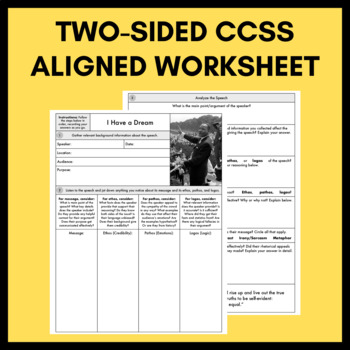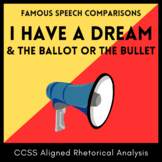Rhetorical Analysis: Ethos, Pathos, Logos, I Have a Dream Speech, MLK, CCSS
- PDF
- Easel Activity
Also included in
- This Martin Luther King Jr. (MLK) lesson bundle includes two great worksheets for teaching students about the life and biography of Martin Luther King Jr. and helping them analyze his famous "I Have a Dream" speech, including its ethos, pathos, and logos. The highly engaging, CCSS aligned Martin LutPrice $4.50Original Price $5.00Save $0.50
- Help your students master their rhetorical analysis skills while analyzing and comparing two famous speeches from history: Martin Luther King Jr.'s "I Have a Dream" speech and Abraham Lincoln's "Gettysburg Address." The two rhetorical analysis worksheets are designed to help your students analyze thPrice $5.00Original Price $6.00Save $1.00
- Help your students master their rhetorical analysis skills while analyzing and comparing two famous speeches from history: Martin Luther King Jr.'s "I Have a Dream" speech and Malcolm X's "The Ballot or the Bullet." The two rhetorical analysis worksheets are designed to help your students analyze thPrice $5.00Original Price $6.00Save $1.00
Description
Teach your students to analyze ethos, pathos, logos, and various rhetorical devices by analyzing Martin Luther King Jr.'s (MLK's) famous speech, "I Have a Dream." Dr. King's famous "I Have a Dream" speech is an important part of any unit of study, whether you're using it to teach U.S. history, rhetoric, speech and debate, Civil Rights, or to celebrate MLK Day. This multi-day worksheet is designed to help students understand the background and context behind this famous speech, practice CCSS aligned speaking and listening skills, and analyze (individually or collaboratively) MLK's message--including the ways its ethos, pathos, and logos affects its meaning.
This product includes:
- Teacher instructions for using the worksheet and tips for effective ways to keep students engaged
- A two-sided worksheet for teaching MLK's famous "I Have a Dream" speech which includes steps for:
1) Researching Dr. Martin Luther King Jr. and the context in which he gave his famous speech
2) Listening to (or reading) his "I Have a Dream" speech and noting how Dr. King uses ethos, pathos, and logos to impact his message
3) Analyzing the rhetorical appeals, rhetorical devices, and the message that Dr. King shared in his speech
Other Resources You Might Like:
- Patrick Henry's "Speech to the Virginia Convention" Worksheet and Text
- FREE Distance Learning Key Event Analysis Worksheet: Plot Analysis, Historical Events
- Poetry Analysis: Phillis Wheatley, On Being Brough from Africa to America, CCSS
*****************************************************************************
Get TPT credit (i.e. FREE MONEY) for future purchases:
Each time you give feedback for a product you have purchased, TpT gives you "feedback credits" that you can use to lower the cost of any of your future purchases. Just go to your My Purchases page, click the green text that says Provide Feedback (beside each purchase), and leave a review!
CLICK HERE TO FOLLOW ME and receive updates about my sales, freebies, and product launches.









